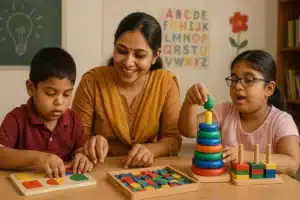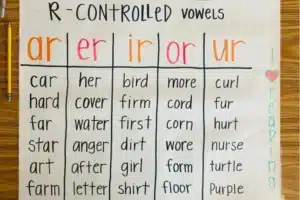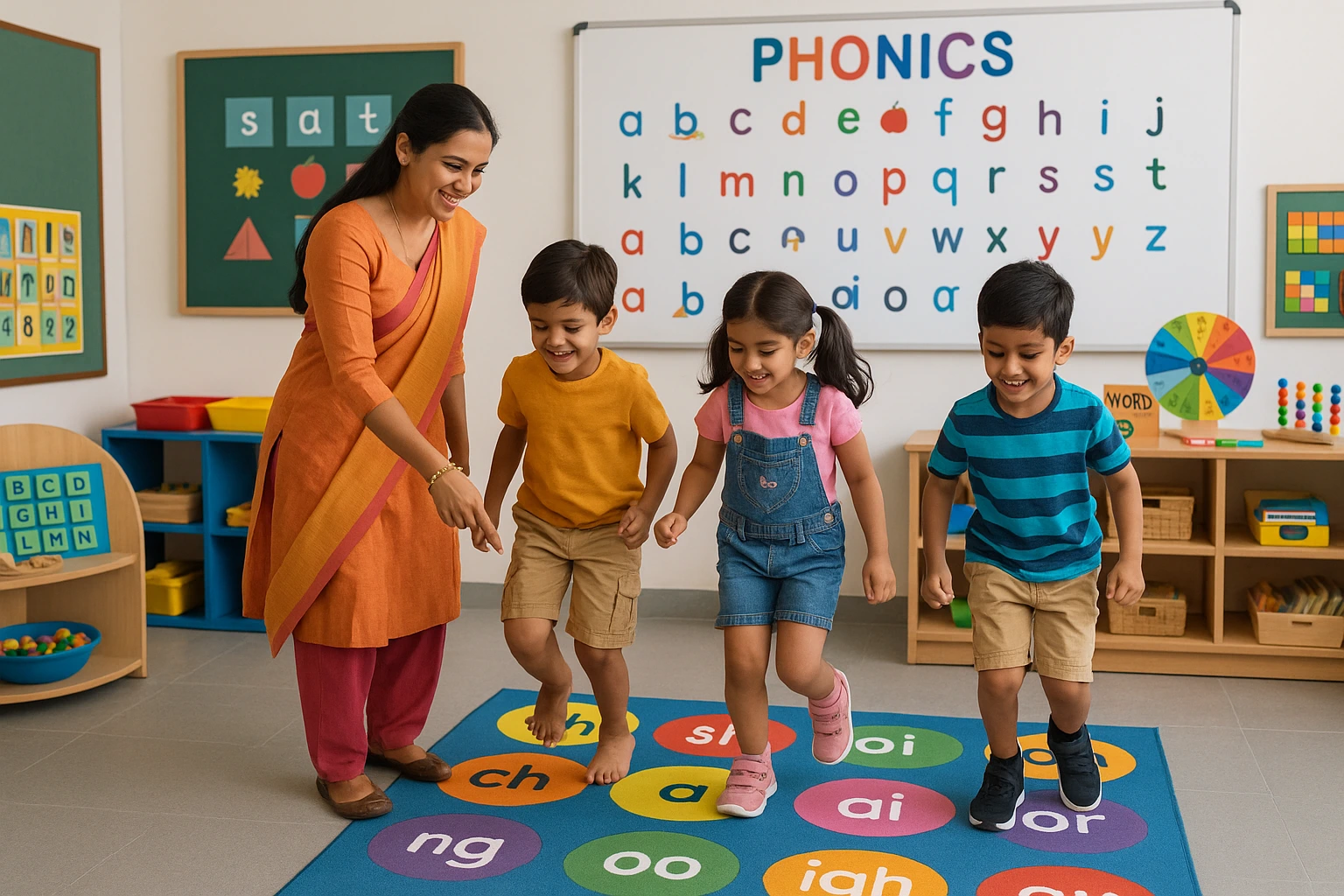
Phonics Kindergarten Activities create the basis for young learners to become adept readers by linking sounds to letters effectively. Using innovative and dynamic approaches, teachers can make learning phonics delightful and entertaining for children. Integrating various Phonics Kindergarten Activities not only improves reading skills but also builds a child’s confidence and enthusiasm toward learning. This article emphasizes practical Phonics Activities for Kindergarten Every Teacher Should Know to help kindergartners learn fundamental phonics concepts effortlessly.
Sound and Letter Games that Build Phonics Basics
Building a strong command of phonics starts with helping children associate sounds with letters in a fun and expressive way. Sound and Letter Games that Build Phonics Basics play an integral role in strengthening this connection, making early reading development both effective and enjoyable.
To Download Brochure about Phonics Courses, Click Here!
For more details of Phonics Courses Call / Whatsapp +919869866277 / +919869546913
Why Sound-Letter Recognition Phonics Kindergarten Activities Matter:
- They form the foundation for decoding and word-building skills.
- Early recognition boosts reading confidence and fluency.
- These Phonics Activities for Kindergarten boost listening skills and phonemic awareness.
- Children learn to recognize patterns in uttered and written language.
Engaging Phonics Activities Every Teacher Should Know:
Matching Cards
Children match letters with pictures illustrating the start sound (e.g., ‘S’ with ‘sun’).
Sound Hunts
Learners explore classroom or home items starting with a particular sound, promoting real-world associations.
Alphabet Puzzles
These puzzles merge letter shapes with corresponding sounds or pictures, strengthening letter-sound links.
Clap the Sound
Teachers say a word, and children clap for each sound they hear. This builds awareness of phoneme segments.
How Trained Teachers Make These Games Purposeful:
Experienced educators know how to turn simple games into targeted learning tools. They choose activities based on individual readiness, ensuring each task builds upon previous knowledge. Trained teachers through Phonics Teacher Courses guide the interaction, provide feedback, and alter the game difficulty to fit learning levels. Their integrated approach keeps the focus on building strong phonics basics while retaining a lively and encouraging surrounding.
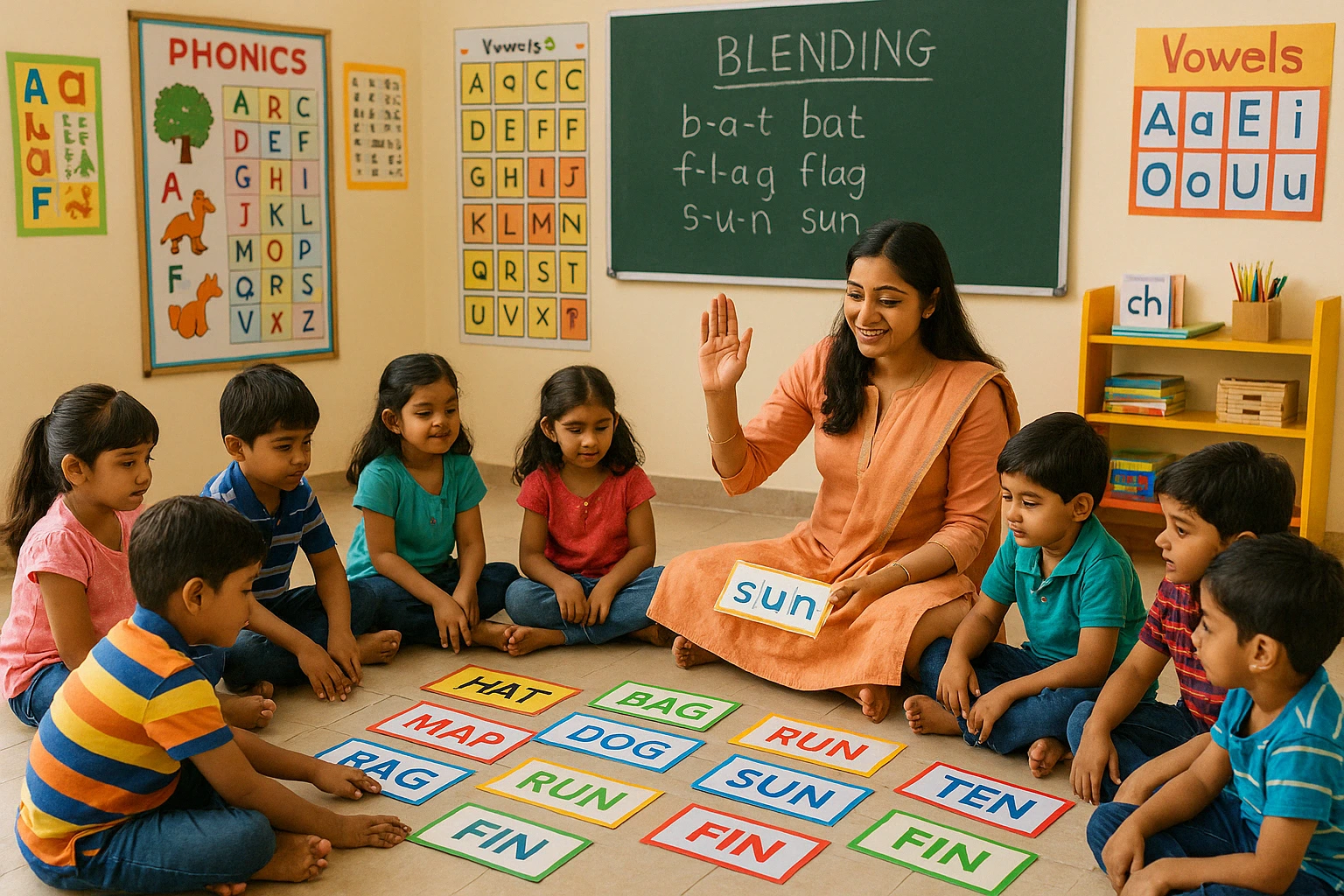
Blending and Segmenting Through Playful Tasks
Blending and Segmenting Through Playful Tasks enable children to read and spell words effectively. It bridges the gap between identifying phonemes and comprehending how they work jointly to form meaningful words.
What is Blending and Segmenting?
Blending involves merging individual sounds to form a whole word. For example, when children listen to the sounds /f/ /i/ /n/, they need to blend them to say- fin.
Segmenting, on the other hand, is the reverse. It means breaking a word apart into its separate sounds. For instance, taking the word sun and identifying it as /s/ /u/ /n/ is segmenting.
Mastering these two skills helps children:
- Interpret unfamiliar words while reading.
- Enhance spelling by hearing each sound in a word.
- Build confidence in their early literacy journey.
Teaching CVC Word Blending and Segmenting
Consonant-vowel-consonant (CVC) words are excellent for familiarizing these skills because they obey a simple and predictable pattern. Words like bat, pen, dog, run, etc. are easy for children to sound out and segment.
Teachers begin by:
- Saying the individual sounds slowly and clearly.
- Encouraging children to blend them together to form the word.
- Then flipping the process by telling a word and requesting the child to segment it into sounds.
This repetitious practice supports their phonemic awareness and establishes the groundwork for more progressive reading.
Using Story Props, Tiles, and Hands-on Phonics Kindergarten Activities
Children learn best through play.
Here’s how Blending and Segmenting Through Playful Tasks help reinforce the concept:
Story Props
- Teachers use toys, puppets, or figurines to act out simple stories.
- As characters “speak” in sounds (e.g., “I have a /h/ /a/ /t/”), children guess the word being said.
Hands-on Games
- Sound-hop mats: Children jump on sounds to blend them.
- Sound puzzles: Match letters to pictures by blending or segmenting.
- Word building blocks: Stack letter blocks to form CVC words.
These Phonics Kindergarten Activities make abstract concepts more concrete and help retain attention during learning sessions.
Role of Phonics Teacher Courses in Making These Effective
Trained teachers through Phonics Courses play a vital role in phonics instruction.
Their expertise allows them to:
- Choose developmentally appropriate Phonics Activities for Kindergarten for each learner.
- Modify games to fit different learning paces and styles.
- Offer corrective feedback and encourage consistent practice.
Through Phonics Courses, teachers learn how to make playful tasks not just entertaining, but targeted and goal-oriented using Phonics Kindergarten Activities, ensuring children make measurable progress in blending and segmenting.
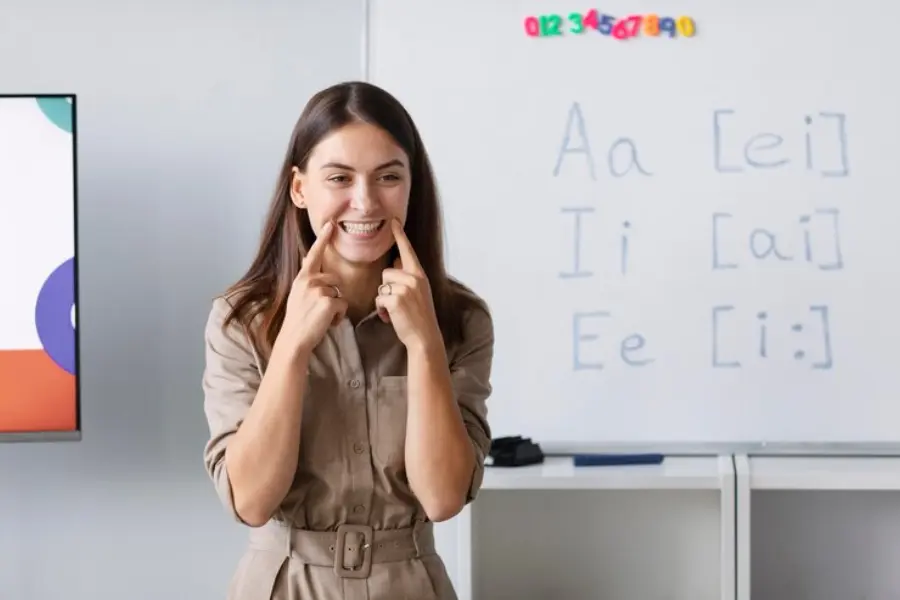
Source: freepik
Interactive Songs and Rhymes to Reinforce Sounds
Music and beat are influential tools in early literacy. Children intrinsically pick up on sound patterns as they sing and chant, making Phonics Learning more effective. Phonics Kindergarten Activities using Interactive Songs and Rhymes to Reinforce Sounds not only increase engagement but also support recollection, repetition, and articulation—all essential elements in phoneme awareness.
How Music and Rhythm Support Phonics Learning:
- Repeating sounds in catchy tunes helps children remember them better.
- Rhymes introduce patterns of sound that improve listening and decoding skills.
- Rhythm builds fluency and clarity in speech.
- Group singing encourages participation and confidence in phonics practice.
Types of Songs That Emphasize Phoneme Awareness:
Alphabet Songs
Reinforce letter names and their corresponding sounds.
Rhyming Songs
Help children detect similar ending sounds, e.g., cat, hat, mat.
Initial Sound Songs
Highlight beginning sounds in playful contexts, such as “B-B-Ball” or “Silly Snake”.
Sound Blending Songs
Guide learners to blend individual sounds into words within a tune.
Teacher Tips from Phonics Teacher Courses:
- Use hand actions or visual props to match each sound in the song.
- Repeat songs regularly and gradually involve children in identifying the sounds.
- Slow down the pace of singing to emphasize phonemes more clearly.
- Keep songs short, engaging, and focused on a specific sound.
Teachers trained through Phonics Teacher Courses are equipped with creative techniques to make the most of Interactive Songs and Rhymes to Reinforce Sounds in class. These Phonics Courses guide educators on how to choose the right songs, adapt them for learning levels, and combine music with visuals for added impact.
At Vidhyanidhi Education Society (Govt. Regd.), the Phonics Teacher Courses empower teachers to use rhythm and rhyme effectively. These Phonics Teacher Courses not only cover sound instruction but also practical strategies to turn Phonics Kindergarten Activities into a daily phonics tool.
Master phonics teaching skills, Join Vidhyanidhi Education Society’s Phonics Course today!
To Download Brochure about Phonics Courses, Click Here!
For more details of Phonics Courses Call / Whatsapp +919869866277 / +919869546913
FAQs
What qualifications do I need to join a certified ECCE program?
You need to have completed Class 12 from a recognized board to be eligible for a certified ECCE program.
How does an ECCE program prepare you for real classrooms?
ECCE programs offer child psychology, lesson planning, and practical training to build classroom readiness.
Is an ECCE certification recognized for preschool jobs in India?
Yes, ECCE certification from institutes like the Vidhyanidhi Education Society is widely accepted for preschool jobs across India.


